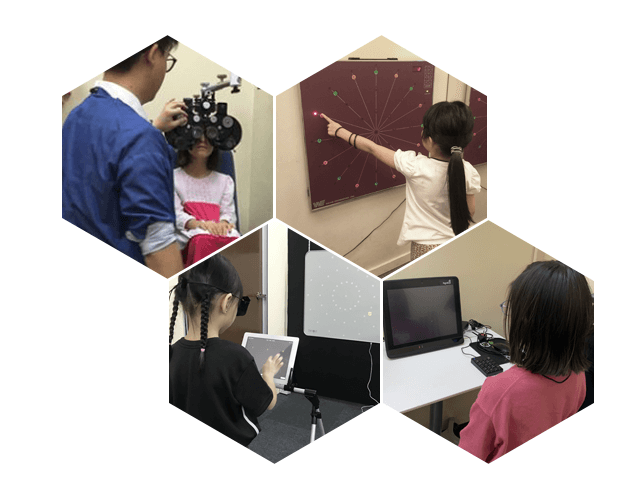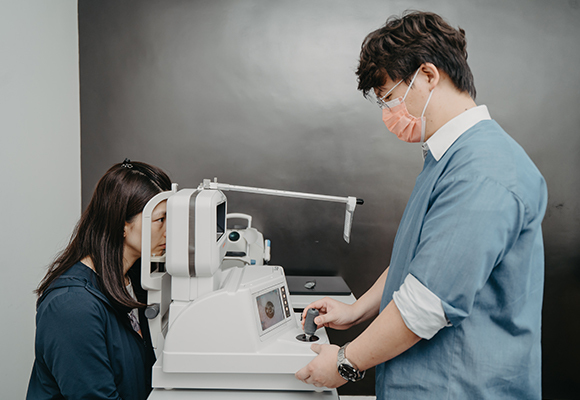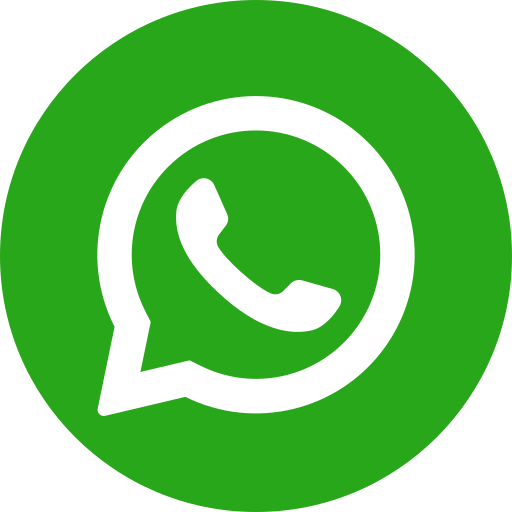Lazy Eye (Child Amblyopia, Mata Malas)
Lazy eye, known as Amblyopia refers to a condition of the brain where it ignores visual information from one eye and vision in that eye does not get better with any type of glasses, contact lenses or surgery.
Lazy Eye (Amblyopia) can be caused by an eye turn. The eye which is not looking where you want to look has to be ignored because the brain cannot make sense out of two different images.
It can also occur when one eye doesn’t see as clearly as the other eye and it isn’t caught early enough. When this happens, the eye becomes lazy because it isn’t being used. Lazy Eye (Child Amblyopia, Mata Malas) does not go away on its own. While many physicians were taught that it is not treatable past the age of 7 or 9 years of age, new research in the field of optometric vision therapy has shown otherwise. Depending on the reason, lazy eye therapy/training can be done no matter how old you are.
What is the difference between Lazy Eye and Eye Turn?
Lazy eye or Child Amblyopia is a problem with visual acuity in one or both eyes that cannot be improved with glasses or contact lenses alone. The brain suppresses the information from either one or both eyes and doesn’t send the visual signal to affected eye, make it eventually become weak. Eye turn also called as “Strabismus” is a problem in which both eyes do not focus on the same point at the same time. The patients not necessarily require vision correction because they may have 20/20 normal visual acuity. They just suffer due to misaligned eye problem.

Why might your child have Lazy Eye?
- Lazy Eye by Birth
Lazy eye has tendency to associate with crossed eyes. It can happen during the early childhood due to the genetic from family. It is normal for a newborn's eyes to cross sometimes during the first few months. By the time, the eyes usually straighten out. Generally, develops up to age 6 years. On the other hand, a child might be more likely to have a lazy eye if they have developmental disabilities. This condition happens because the vision in the eyes might not develop the way it should.
- Lazy Eye by Accident
Lazy eye can result from strokes, car accidents, concussions etc. Research showed that 90% of traumatic brain injury (TBI) patients experience some of visual problems due to the disruption of communication between the eyes and the brain. Injury to any part of visual pathways can affect the field of vision, the position of the eye and how the eye moves.
Common Signs and Symptoms of Lazy Eye (Amblyopia)
Squints or closes one eye
Covers one eye while reading or looking at something close up
Inability to respond to some visual stimuli
Difficulty following moving objects
Bumps into objects while walking
Trouble with depth perception
Poor eye-hand coordination (poor handwriting, for example)
Uses finger to keep place when reading
Skips words when reading out loud
Moves head when reading
Complains of blurry vision or double images (diplopia)
Has trouble seeing 3D
How would Lazy Eye affect your child
Lazy Eye (Amblyopia, Mata Malas) can have a major impact on how the child functions in school or succeeds in life. Here are some of the examples:
- May experience double vision (diplopia) or/and blurry vision
- Frequent loss of place when reading
- Headaches, eye strain and inability to stay focused on a visual task for any period of time
- Seem to be clumsy or have a lot of accidents
- Turn head to see things
- Close one eye while reading
- Close up tasks become difficult
- Require good eye-hand coordination skills such as writing, drawing, throwing or catching a ball become difficult
- Poor self-esteem
Is it possible to fix the Lazy Eye for my child?
Golden/Critical Period
While you may have been told that there is a golden period where your child can treat lazy eye, and that after this period it is no longer possible for lazy eye treatment - research has found that it is possible to correct this condition no matter how old your child is.
Through Behavioral and Developmental Optometry, we are able to help your child learn how to use their eyes correctly at any age. In order to see if we can help your child in treating vision problems lazy eye (amblyopia, mata malas), schedule a Neuro-functional vision evaluation with our Behavioral and Developmental Optometrist.
Available Lazy Eye Treatment for Children in Malaysia
Understanding the different lazy eye treatment has different efficiency to your child. However, the important part is how to fix the lazy eye for your child? There are 3 approaches to treat the lazy eye in Malaysia.
- Occlusion therapy using an eye patch
The “good” eye is covered up with a special patch for a few hours a day for several months, so the “lazy” eye is forced to work. However, using a patch to treat a lazy eye can be time-consuming and can often be an unpleasant experience for the child until they get used it. This is because you are making their vision worse by taking their good eye away from them.
- Eye drops
Atropine eye drops can be used to temporarily make it difficult for the “good” eye to see properly. This drug dilates the pupil and numbs the muscles of the good eye making the lens unable to focus for a few hours, so the weaker eye is forced to work. However, the side effects that can occur for this treatment included eye irritation, redness of the eye and headaches.
At Sun Time Vision Specialists Centre, our specialized behavioral and developmental optometrist provide a very effective, non-surgical treatment that helps our patients eliminate lazy eye (Amblyopia, Mata Malas).
We are able to teach our patients to use their two eyes together correctly which gets rid of the lazy eye. Just as there is physical therapy or speech therapy, there is Vision Therapy— therapy for the eyes. Our Behavioral and Developmental optometrist at Sun Time Vision Specialists Centre are certified to provide optometric Vision Therapy. We are able to teach children and adults how to use their two eyes correctly, and to treat a variety of vision problems which are not fully treatable with glasses, contact lenses or surgery.
Get a free consultation to correct your child’s Lazy Eye
We understand that you might have a number of questions regarding amblyopia (lazy eye, mata malas); especially if this is the first time you are hearing that your child may have a vision problem such as blurry or double vision. Please feel free to call our office with your questions. Phone 03-2110 3967 or Whatsapp us. The first step to treat lazy eye (Amblyopia, Mata Malas) is to schedule a functional vision evaluation to determine to what degree the vision problems are contributing to your child’s difficulties. Once the testing is completed, Our Behavioral and Developmental Optometrist will meet with you in a separate appointment to review the results and go over the recommended program to treat Child amblyopia.


